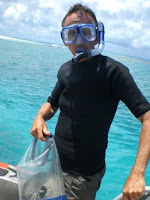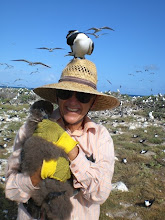
When we visited East Island in mid May we saw a turtle that was entangled in line and netting with a white plastic bottle trailing along on the surface. We waited for quite a time for it to come up on the beach so we could cut it free but had no success. A number of weeks later the seal researchers found that same turtle on the beach and were able to cut it free from the trailing line and bleach bottle. More weeks passed and the story resumed. I was in need of a mesh bag for my snorkel gear and found one on the debris pile that collects at Tern. It was in need of repair and I spent several hours stitching it into a serviceable bag. Last week when I went out on the boat with Derek and Mark I mentioned my new found bag and Derek said that it was part of the debris that he had cut loose from the entangled turtle. Few turtles are lucky enough to be freed alive from plastic and mesh debris and few people have a snorkel bag with as good a story as mine.
















































